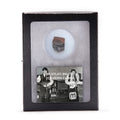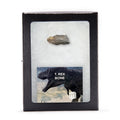Petrified Branch - Full Slice


Petrified Branch - Full Slice









Above: Front of Specimen Card
"When the plant deposits are as thoroughly explored as the animal deposits have been, stratigraphic geology will receive much valuable aid." ~ Frank Hall Knowlton, USGS Botanist, 1889.
Petrified wood is a unique type of fossil that preserves the impressions of the organic material down to a cellular level. The most common plant fossils are often only impressions of anatomical details left upon soft earth during fossilization. Petrified wood, however, is a substance wherein minerals fill and replace cavities left by buried plant material, allowing for an in-depth and three-dimensional look at the original plant.

Above: Petrified Branch specimens. Lovely in the case or out on display. The material is extremely hard so no worries about scratching. Great size to hold and contemplate deep time... way better than a fidget spinner. 😎
This specimen is a highly polished, cross-cut segment of a petrified tree branch. This particular specimen is an Araucaria from Madagascar. The specimen is presented in a classic, glass-topped riker display case measuring 4 1/2" x 3 1/2". A small information card is also enclosed, which also serves as the certificate of authenticity.
Examinations of petrified wood left from such trees indicate they would have lived during the late Triassic period, 200 million years ago. This would have made them a prime source of food for sauropod dinosaurs. These trees feature straight, columnar trunks and branches covered in overlapping, scale-like leaves. When mature, the trees could have a diameter of up to 9 feet and stood over 190 feet tall.
Please Note: Like the branches of any tree, the size, color, and patterns of this specimen vary widely. They are all highly polished on both sides and roughly 2" (5cm) in diameter.
More about Petrified Wood
The process begins when wood is buried underneath sediment or volcanic ash. Under these conditions, the structure of the plant can be kept safe from decomposing organisms due to a lack of oxygen. At this point, there are two mechanisms by which petrification occurs: permineralization and replacement. Permineralization is the filling of cavities within the plant, ranging from the insides of cells and tissues to non-native spaces such as gaps created by rot or insects. Replacement follows after the degradation of cellular walls and describes the process through which sediment fills the gaps left behind. Both these mechanisms require minerals to be transported through the plant system, often time by sediment-laden groundwater.
Petrified wood is found in a wide range of colors, from cool blues and greens to warm reds and pinks. Silicates like quartz are the predominant mineral in petrified wood which, in a pure form, is colorless. Crystal defects caused by inclusions of other elements can change the color of the mineral, making these trace elements responsible for the array of sunset colors that appear within petrified wood.
Iron is the most influential element in determining color, as the inclusion of the element can manifest as a whole rainbow of options. Even within the same fossil, changes in colors are directly connected to a change in the amount of iron present at a certain spot. As fossilization occurs over a very long timespan, stops and starts in petrification occur causing different colors to appear in different areas. This is what gives petrified wood its distinct and beautiful appearance.
Petrified wood can be found all over the world. The Petrified Forest National Park in Arizona contains an enormous deposit of petrified wood in the Chinle formation. This formation was exposed through wind and water erosion. Other major deposits have been found in Brazil, Indonesia, and the coast of Madagascar.
Further Reading
Mustoe, George. “Wood Petrifaction: A New View of Permineralization and Replacement.” Geosciences, vol. 7, pp. 1-17, 2017. 10.3390/geosciences7040119.
Mustoe, George and Acosta, Marisa. “Origin of Petrified Wood Color.” Geosciences, vol. 6, 2016.
Mustoe, George. “Mineralogy of Non-Silicified Fossil Wood.” Geosciences, vol 8, 2018.
“Geology and the Painted Desert.” National Park Service. 2006.
Knowlton, Frank Hall. “Fossil wood and Lignite of the Potomac Formation.” U.S. Geological Survey, no. 56, 1889.
Ash, Sidney and Creber, Geoffrey. “The Late Triassic Araucarioxylon Arizonicum trees of the Petrified Forest National Park, Arizona, USA.” Paleontology, vol. 43, no. 1, pp. 15-28, 2000.

Above: Back of Specimen Card










